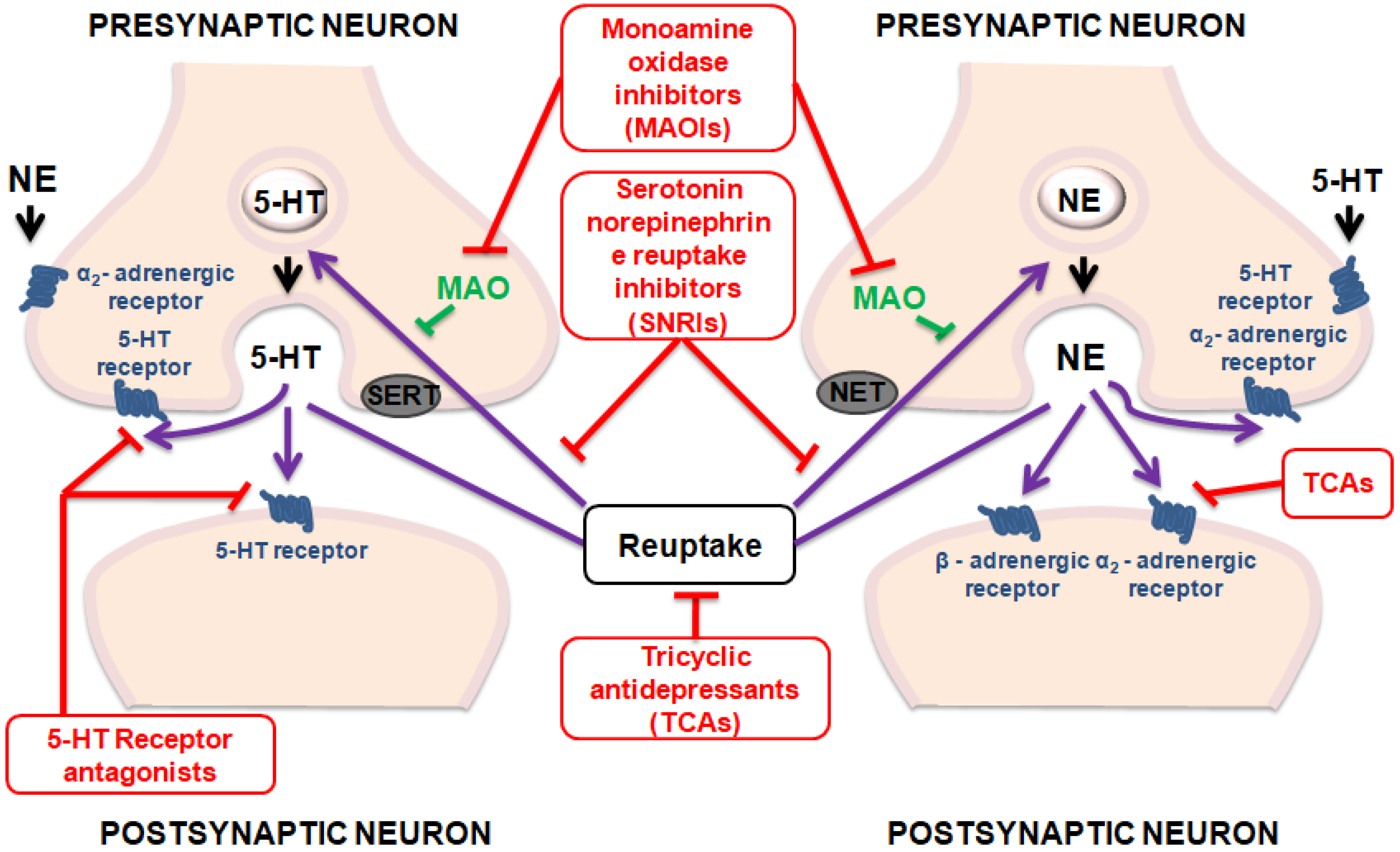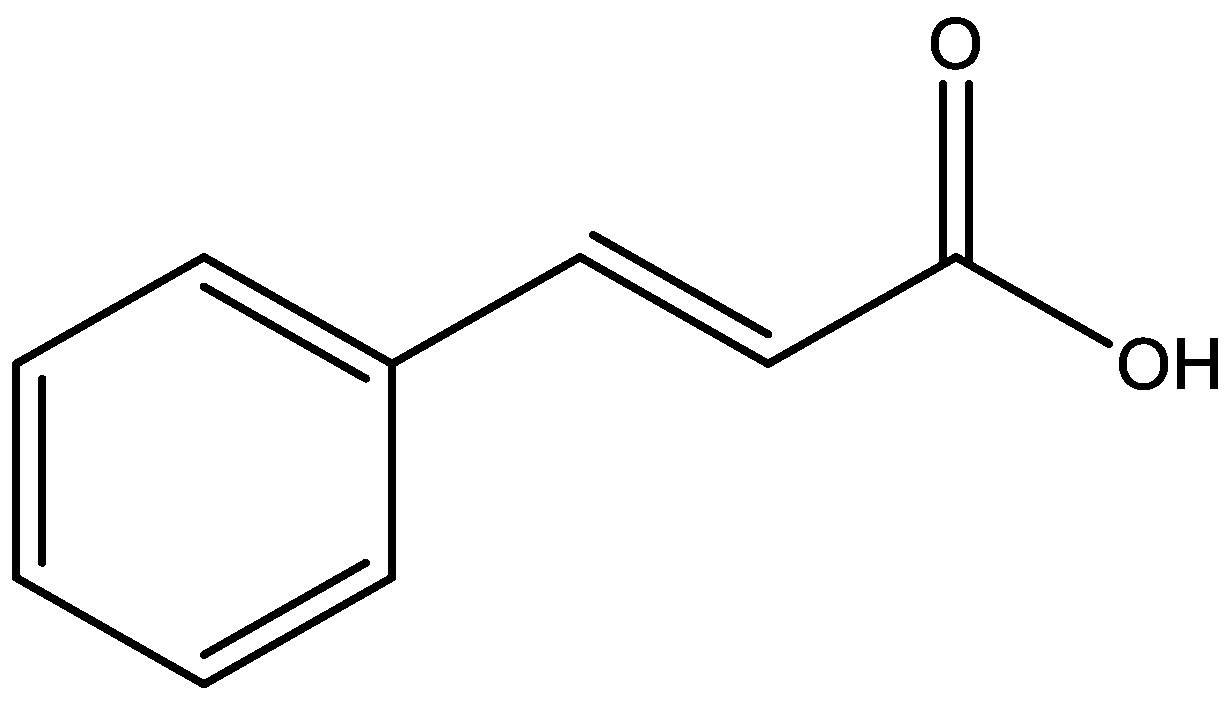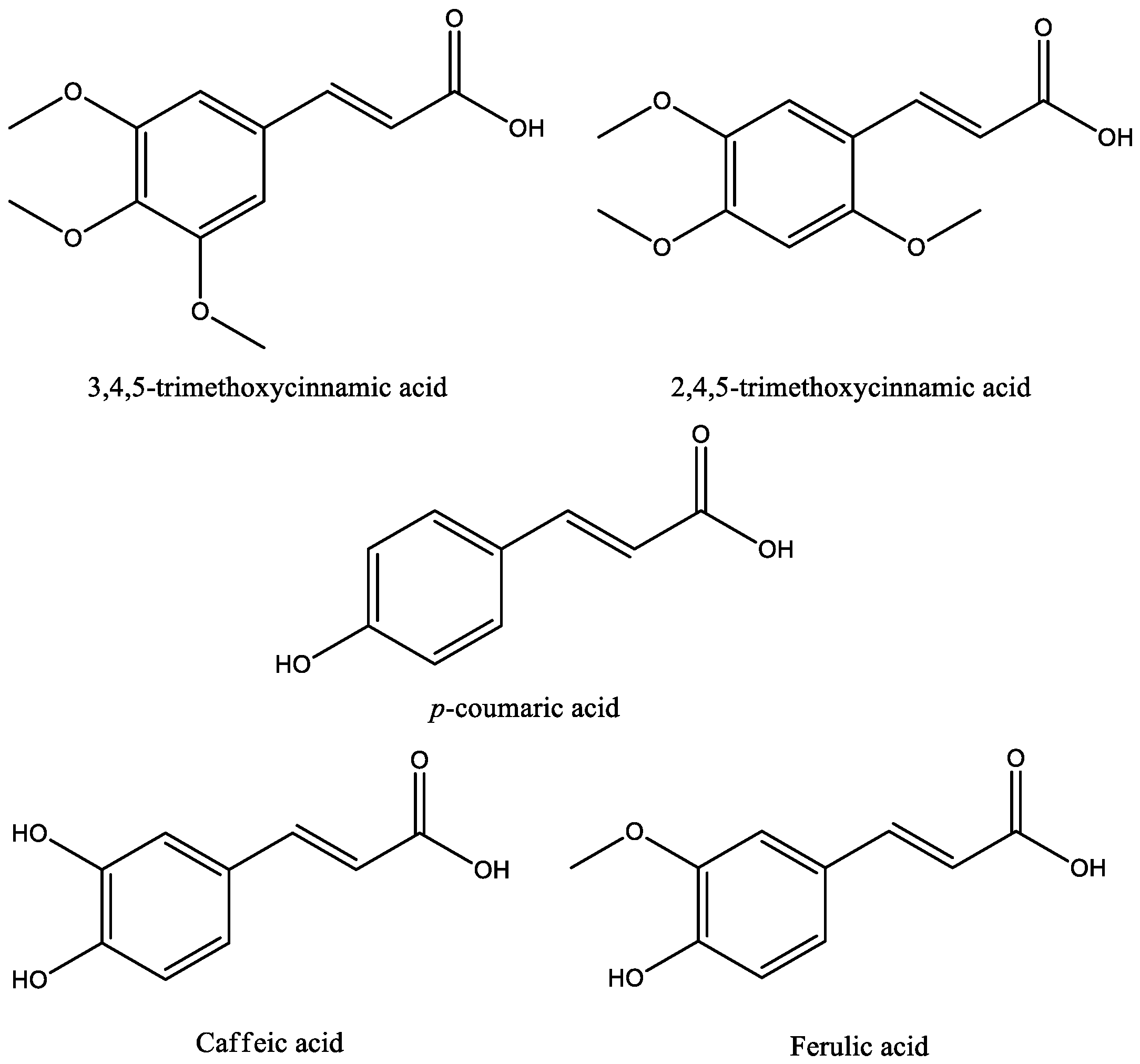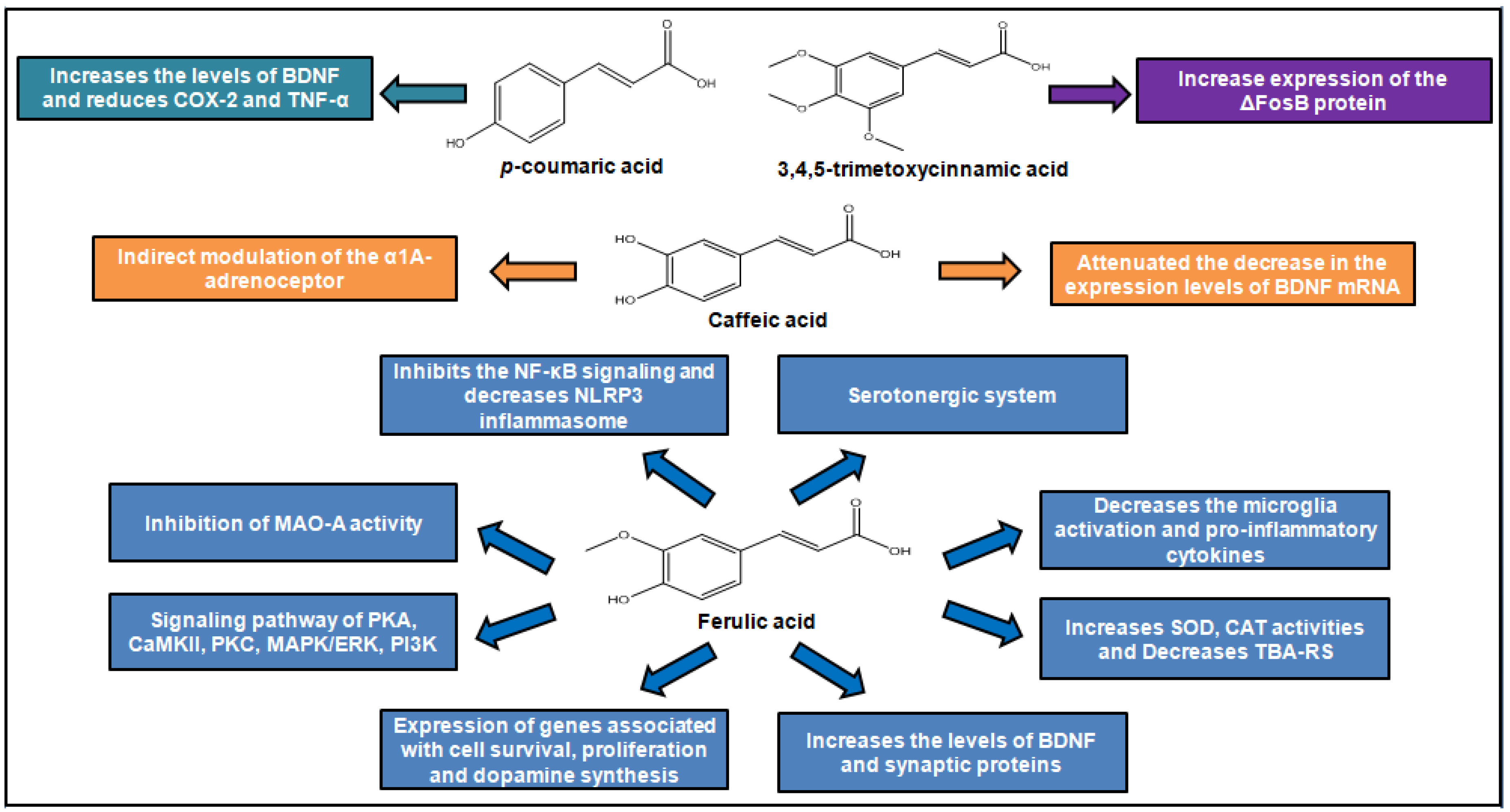Antidepressant Potential of Cinnamic Acids: Mechanisms of Action and Perspectives in Drug Development
Abstract
1. Introduction
2. Materials and Methods
3. Antidepressant Activity of Cinnamic Acids
4. Conclusions
Author Contributions
Funding
Acknowledgments
Conflicts of Interest
Abbreviations
| 5-HIAA | 5-Hydroxyindoleacetic acid |
| 5-HT | Serotonin |
| 5-LOX | 5-Lipoxygenase |
| BDNF | Brain-derived neurotrophic factor |
| CaMKII | Ca2+/calmodulin-dependent protein kinase II |
| CAT | Catalase |
| COX-2 | Cyclooxygenase-2 |
| EPM | Elevated plus maze test |
| FST | Forced swim test |
| IL-1β | Interleukin-1β |
| IL-8 | Interleukin-8 |
| LPS | Lipopolysaccharide |
| MAO | Monoamine oxidase |
| MAO-A | Monoamine oxidase A |
| MAPK/ERK | Mitogen-activated protein kinases/extracellular signal-regulated kinases |
| MHPG | 3-Methoxy-4-hydroxyphenylglycol |
| NF-κB | Nuclear factor kappa B |
| NE | Norepinephrine |
| NET | Norepinephrine transporter |
| NO | Nitric oxide |
| OFT | Open field test |
| PI3K | Phosphoinositide 3-kinases |
| PKA | Protein kinase A |
| PKC | Protein kinase C |
| ROS | Reactive species of oxygen |
| SERT | Serotonin transporter |
| SNRI | Serotonin norepinephrine reuptake inhibitors |
| SOD | Superoxide dismutase |
| SSRI | Selective serotonin reuptake inhibitor |
| SST | Sucrose splash test |
| TBARS | Thiobarbituric acid reactive substances |
| TCA | Tricyclic antidepressants |
| TYR | Tyrosine |
| TMCA | 2,4,5-Trimethoxycinnamic acid |
| TNF-α | Tumor necrosis factor-α |
| TRP | Tryptophan |
| TST | Tail suspension test |
References
- Peres, M.F.P.; Mercante, J.P.P.; Tobo, P.R.; Kamei, H.; Bigal, M.E. Anxiety and depression symptoms and migraine: A symptom-based approach research. J. Headache Pain 2017, 18, 37. [Google Scholar] [CrossRef] [PubMed]
- Smith, K. Mental health: A world of depression. Nature 2014, 515, 181. [Google Scholar] [CrossRef] [PubMed]
- Bravender, T. Mental Disorders and Learning Disabilities in Children and Adolescents: Depression in Adolescents. FP Essent. 2018, 475, 30. [Google Scholar] [PubMed]
- Wang, S.; Blazer, D.G. Depression and cognition in the elderly. Annu Rev. Clin. Psychol. 2015, 11, 331. [Google Scholar] [CrossRef]
- Gournellis, R.; Tournikioti, K.; Touloumi, G.; Thomadakis, C.; Michalopoulou, P.G.; Michopoulos, I.; Christodoulou, C.; Papadopoulou, A.; Douzenis, A. Psychotic (delusional) depression and completed suicide: A systematic review and meta-analysis. Ann. Gen. Psychiatry 2018, 17, 39. [Google Scholar] [CrossRef]
- Hawton, K.; Casanas, I.C.C.; Haw, C.; Saunders, K. Risk factors for suicide in individuals with depression: A systematic review. J. Affect. Disord. 2013, 147, 17. [Google Scholar] [CrossRef]
- Krishnan, V.; Nestler, E.J. The molecular neurobiology of depression. Nature 2008, 455, 894. [Google Scholar] [CrossRef]
- Peng, G.J.; Tian, J.S.; Gao, X.X.; Zhou, Y.Z.; Qin, X.M. Research on the Pathological Mechanism and Drug Treatment Mechanism of Depression. Curr. Neuropharmacol. 2015, 13, 514. [Google Scholar] [CrossRef]
- Ruiz, N.A.L.; Del Angel, D.S.; Olguin, H.J.; Silva, M.L. Neuroprogression: The hidden mechanism of depression. Neuropsychiatr. Dis. Treat. 2018, 14, 2837. [Google Scholar] [CrossRef]
- Uchida, S.; Yamagata, H.; Seki, T.; Watanabe, Y. Epigenetic mechanisms of major depression: Targeting neuronal plasticity. Psychiatry Clin. Neurosci 2018, 72, 212. [Google Scholar] [CrossRef]
- Liu, C.H.; Zhang, G.Z.; Li, B.; Li, M.; Woelfer, M.; Walter, M.; Wang, L. Role of inflammation in depression relapse. J. Neuroinflammation 2019, 16, 90. [Google Scholar] [CrossRef] [PubMed]
- Reus, G.Z.; Silva, R.H.; de Moura, A.B.; Presa, J.F.; Abelaira, H.M.; Abatti, M.; Vieira, A.; Pescador, B.; Michels, M.; Ignacio, Z.M.; et al. Early Maternal Deprivation Induces Microglial Activation, Alters Glial Fibrillary Acidic Protein Immunoreactivity and Indoleamine 2,3-Dioxygenase during the Development of Offspring Rats. Mol. Neurobiol. 2019, 56, 1096. [Google Scholar] [CrossRef] [PubMed]
- Oglodek, E.A. Changes in the concentrations of inflammatory and oxidative status biomediators (MIP-1 alpha, PMN elastase, MDA, and IL-12) in depressed patients with and without posttraumatic stress disorder. Pharmacol Rep. 2018, 70, 110. [Google Scholar] [CrossRef] [PubMed]
- Stanners, M.N.; Barton, C.A.; Shakib, S.; Winefield, H.R. Depression diagnosis and treatment amongst multimorbid patients: A thematic analysis. BMC Fam. Pract. 2014, 15, 124. [Google Scholar] [CrossRef] [PubMed]
- Blackburn, T.P. Depressive disorders: Treatment failures and poor prognosis over the last 50 years. Pharmacol. Res. Perspect. 2019, 7, e00472. [Google Scholar] [CrossRef] [PubMed]
- Hollon, S.D.; Cohen, Z.D.; Singla, D.R.; Andrews, P.W. Recent Developments in the Treatment of Depression. Behav. Ther. 2019, 50, 257. [Google Scholar] [CrossRef]
- López-Rubalcava, C.; Estrada-Camarena, E. Mexican medicinal plants with anxiolytic or antidepressant activity: Focus on preclinical research. J. Ethnopharmacol. 2016, 20, 377–391. [Google Scholar]
- Guzman, J.D.; Mortazavi, P.N.; Munshi, T.; Evangelopoulos, D.; Mchugh, T.D.; Gibbons, S.; Malkinson, J.; Bhakta, S. 2-Hydroxy-substituted cinnamic acids and acetanilides are selective growth inhibitors of Mycobacterium tuberculosis. MedChemComm 2014, 5, 47–50. [Google Scholar] [CrossRef]
- Tian, Y.; Liu, W.; Lu, Y.; Wang, Y.; Chen, X.; Bai, S.; Zhao, Y.; He, T.; Lao, F.; Shang, Y.; et al. Naturally Occurring Cinnamic Acid Sugar Ester Derivatives. Molecules 2016, 21, 1402. [Google Scholar] [CrossRef]
- de Cássia, D.S.E.S.; Andrade, L.N.; Dos Reis, B.D.O.R.; de Sousa, D.P. A review on anti-inflammatory activity of phenylpropanoids found in essential oils. Molecules 2014, 19, 1459–1480. [Google Scholar] [CrossRef]
- Sova, M. Antioxidant and antimicrobial activities of cinnamic acid derivatives. Mini Rev. Med. Chem. 2012, 12, 749–767. [Google Scholar] [CrossRef] [PubMed]
- Anantharaju, P.G.; Gowda, P.C.; Vimalambike, M.G.; Madhunapantula, S.V. An overview on the role of dietary phenolics for the treatment of cancers. Nutr. J. 2016, 15, 99. [Google Scholar] [CrossRef] [PubMed]
- Alam, M.A.; Subhan, N.; Hossain, H.; Hossain, M.; Reza, H.M.; Rahman, M.M.; Ullah, M.O. Hydroxycinnamic acid derivatives: A potential class of natural compounds for the management of lipid metabolism and obesity. Nutr. Metab. 2016, 13, 27. [Google Scholar] [CrossRef] [PubMed]
- Liu, P.; Hu, Y.; Guo, D.H.; Wang, D.X.; Tu, H.H.; Ma, L.; Xie, T.T.; Kong, L.Y. Potential antidepressant properties of Radix polygalae (Yuan Zhi). Phytomedicine 2010, 17, 794–799. [Google Scholar] [CrossRef]
- Szwajgier, D.; Borowiec, K.; Pustelniak, K. The Neuroprotective Effects of Phenolic Acids: Molecular Mechanism of Action. Nutrients 2017, 9, 477. [Google Scholar] [CrossRef]
- Magoulas, G.E.; Papaioannou, D. Bioinspired syntheses of dimeric hydroxycinnamic acids (lignans) and hybrids, using phenol oxidative coupling as key reaction, and medicinal significance thereof. Molecules 2014, 19, 19769. [Google Scholar] [CrossRef]
- Bialecka-Florjanczyk, E.; Fabiszewska, A.; Zieniuk, B. Phenolic Acids Derivatives-Biotechnological Methods of Synthesis and Bioactivity. Curr. Pharm. Biotechnol. 2018, 19, 1098. [Google Scholar] [CrossRef]
- Wu, S.; Zhang, Y.; Ren, F.; Qin, Y.; Liu, J.; Liu, J.; Wang, Q.; Zhang, H. Structure-affinity relationship of the interaction between phenolic acids and their derivatives and beta-lactoglobulin and effect on antioxidant activity. Food Chem. 2018, 245, 613. [Google Scholar] [CrossRef]
- Dludla, P.V.; Nkambule, B.B.; Jack, B.; Mkandla, Z.; Mutize, T.; Silvestri, S.; Orlando, P.; Tiano, L.; Louw, J.; Mazibuko-Mbeje, S.E. Inflammation and Oxidative Stress in an Obese State and the Protective Effects of Gallic Acid. Nutrients 2019, 11, 23. [Google Scholar] [CrossRef]
- Oliviero, F.; Scanu, A.; Zamudio-Cuevas, Y.; Punzi, L.; Spinella, P. Anti-inflammatory effects of polyphenols in arthritis. J. Sci. Food Agric. 2018, 98, 1653. [Google Scholar] [CrossRef]
- Gaspar, A.; Garrido, E.M.; Esteves, M.; Quezada, E.; Milhazes, N.; Garrido, J.; Borges, F. New insights into the antioxidant activity of hydroxycinnamic acids: Synthesis and physicochemical characterization of novel halogenated derivatives. Eur. J. Med. Chem. 2009, 44, 2092. [Google Scholar] [CrossRef] [PubMed]
- Razzaghi-Asl, N.; Garrido, J.; Khazraei, H.; Borges, F.; Firuzi, O. Antioxidant properties of hydroxycinnamic acids: A review of structure- activity relationships. Curr. Med. Chem. 2013, 20, 4436. [Google Scholar] [CrossRef] [PubMed]
- Castagne, V.; Moser, P.; Roux, S.; Porsolt, R.D. Rodent models of depression: Forced swim and tail suspension behavioral despair tests in rats and mice. Curr. Protoc. Neurosci. 2011, 55, 8–10. [Google Scholar] [CrossRef] [PubMed]
- Yan, H.C.; Cao, X.; Das, M.; Zhu, X.H.; Gao, T.M. Behavioral animal models of depression. Neurosci. Bull. 2010, 26, 327. [Google Scholar] [CrossRef]
- Abelaira, H.M.; Reus, G.Z.; Quevedo, J. Animal models as tools to study the pathophysiology of depression. Braz. J. Psychiatry 2013, 35, S112–S120. [Google Scholar] [CrossRef]
- Nakazawa, T.; Yasuda, T.; Ueda, J.; Ohsawa, K. Antidepressant-like effects of apigenin and 2, 4, 5-trimethoxycinnamic acid from Perilla frutescens in the forced swimming test. Biol. Pharm. Bull. 2003, 26, 474–480. [Google Scholar] [CrossRef]
- Leem, Y.H.; Oh, S. 3, 4, 5-Trimethoxycinnamin acid ameliorates restraint stress-induced anxiety and depression. Neurosci. Lett. 2015, 585, 54–59. [Google Scholar] [CrossRef]
- Takeda, H.; Tsuji, M.; Inazu, M.; Egashira, T.; Matsumiya, T. Rosmarinic acid and caffeic acid produce antidepressive-like effect in the forced swimming test in mice. Eur. J. Pharmacol. 2002, 449, 261–267. [Google Scholar] [CrossRef]
- Takeda, H.; Tsuji, M.; Miyamoto, J.; Masuya, J.; Iimori, M.; Matsumiya, T. Caffeic acid produces antidepressive-and/or anxiolytic-like effects through indirect modulation of the α1A-adrenoceptor system in mice. Neuroreport 2003, 14, 1067–1070. [Google Scholar] [CrossRef]
- Takeda, H.; Tsuji, M.; Yamada, T.; Masuya, J.; Matsushita, K.; Tahara, M.; Matsumiya, T.; Limore, M.; Matsumiya, T. Caffeic acid attenuates the decrease in cortical BDNF mRNA expression induced by exposure to forced swimming stress in mice. Eur. J. Pharmacol. 2006, 534, 115–121. [Google Scholar] [CrossRef]
- Dzitoyeva, S.; Imbesi, M.; Uz, T.; Dimitrijevic, N.; Manev, H.; Manev, R. Caffeic acid attenuates the decrease of cortical BDNF transcript IV mRNA induced by swim stress in wild-type but not in 5-lipoxygenase-deficient mice. J. Neural Transm. Suppl. 2008, 115, 823–827. [Google Scholar] [CrossRef] [PubMed]
- Huang, D.; Zhang, L.; Yang, J.Q.; Luo, Y.; Cui, T.; Du, T.T.; Jiang, X.H. Evaluation on monoamine neurotransmitters changes in depression rats given with sertraline, meloxicam or/and caffeic acid. Genes Dis. 2019, 6, 167–175. [Google Scholar] [CrossRef] [PubMed]
- Zdunska, K.; Dana, A.; Kolodziejczak, A.; Rotsztejn, H. Antioxidant Properties of Ferulic Acid and Its Possible Application. Skin Pharmacol. Physiol. 2018, 31, 332. [Google Scholar] [CrossRef] [PubMed]
- Zeni, A.L.B.; Zomkowski, A.D.E.; Maraschin, M.; Rodrigues, A.L.S.; Tasca, C.I. Ferulic acid exerts antidepressant-like effect in the tail suspension test in mice: Evidence for the involvement of the serotonergic system. Eur. J. Pharmacol. 2012, 679, 68–74. [Google Scholar] [CrossRef]
- Zeni, A.L.B.; Camargo, A.; Dalmagro, A.P. Ferulic acid reverses depression-like behavior and oxidative stress induced by chronic corticosterone treatment in mice. Steroids 2017, 125, 131–136. [Google Scholar] [CrossRef]
- Chen, J.; Lin, D.; Zhang, C.; Li, G.; Zhang, N.; Ruan, L.; Yan, K.; Li, J.; Yu, X.; Xie, X.; et al. Antidepressant-like effects of ferulic acid: Involvement of serotonergic and norepinergic systems. Metab. Brain Dis. 2015, 30, 129–136. [Google Scholar] [CrossRef]
- Zhang, Y.J.; Huang, X.; Wang, Y.; Xie, Y.; Qiu, X.J.; Ren, P.; Gao, L.C.; Zhou, H.H.; Zhange, H.Y.; Qiao, M.Q. Ferulic acid-induced anti-depression and prokinetics similar to Chaihu–Shugan–San via polypharmacology. Brain Res. Bull. 2011, 86, 222–228. [Google Scholar] [CrossRef]
- Sasaki, K.; Iwata, N.; Ferdousi, F.; Isoda, H. Antidepressant-Like Effect of Ferulic Acid via Promotion of Energy Metabolism Activity. Mol. Nutr. Food Res. 2019, 63, 1900327. [Google Scholar] [CrossRef]
- Lenzi, J.; Rodrigues, A.F.; de Sousa Rós, A.; de Castro, B.B.; de Lima, D.D.; Dal Magro, D.D.; Zeni, A.L.B. Ferulic acid chronic treatment exerts antidepressant-like effect: Role of antioxidant defense system. Metab. Brain Dis. 2015, 30, 1453–1463. [Google Scholar] [CrossRef]
- Li, G.; Ruan, L.; Chen, R.; Wang, R.; Xie, X.; Zhang, M.; Chen, L.; Yan, Q.; Reed, M.; Chen, J.; et al. Synergistic antidepressant-like effect of ferulic acid in combination with piperine: Involvement of monoaminergic system. Metab. Brain Dis. 2015, 30, 1505–1514. [Google Scholar] [CrossRef]
- Liu, Y.M.; Hu, C.Y.; Shen, J.D.; Wu, S.H.; Li, Y.C.; Yi, L.T. Elevation of synaptic protein is associated with the antidepressant-like effects of ferulic acid in a chronic model of depression. Physiol. Behav. 2017, 169, 184–188. [Google Scholar] [CrossRef] [PubMed]
- Zheng, X.; Cheng, Y.; Chen, Y.; Yue, Y.; Li, Y.; Xia, S.; Li, Y.; Deng, H.; Zang, J.; Cao, Y. Ferulic Acid Improves Depressive-Like Behavior in Prenatally-Stressed Offspring Rats via Anti-Inflammatory Activity and HPA Axis. Int. J. Mol. Sci. 2019, 20, 493. [Google Scholar] [CrossRef] [PubMed]
- Lee, S.; Kim, H.B.; Hwang, E.S.; Kim, E.S.; Kim, S.S.; Jeon, T.D.; Song, M.; Li, J.S.; Chung, M.C.; Maeng, S.; et al. Antidepressant-like effects of p-coumaric acid on LPS-induced depressive and inflammatory changes in rats. Exp. Neurobiol. 2018, 27, 189–199. [Google Scholar] [CrossRef] [PubMed]
- Barauna, S.C.; Delwing-Dal, M.D.; Brueckheimer, M.B.; Maia, T.P.; Sala, G.A.B.N.; Döhler, A.W.; Harger, M.C.; de Melo, D.F.M.; de Gasper, A.L.; Alberton, M.D.; et al. Antioxidant and antidepressant-like effects of Eugenia catharinensis D. Legrand in an animal model of depression induced by corticosterone. Metab. Brain Dis. 2018, 33, 1985–1994. [Google Scholar] [CrossRef] [PubMed]
- Adeoluwa, A.O.; Aderibigbe, O.A.; Agboola, I.O.; Olonode, T.E.; Ben-Azu, B. Butanol Fraction of Olax subscorpioidea Produces Antidepressant Effect: Evidence for the Involvement of Monoaminergic Neurotransmission. Drug Res. (Stuttg). 2019, 69, 53–60. [Google Scholar] [CrossRef]
- Pauleti, N.N.; Mello, J.; Siebert, D.A.; Micke, G.A.; de Albuquerque, C.A.C.; Alberton, M.; Barauna, S.C. Characterisation of phenolic compounds of the ethyl acetate fraction from Tabernaemontana catharinensis and its potential antidepressant-like effect. Nat. Prod. Res. 2018, 32, 1987–1990. [Google Scholar] [CrossRef]




| Compound | Animal Species | Dose and via of Administration | Behavioral Test | Observed Effects | Mechanism of Action | Reference |
|---|---|---|---|---|---|---|
| 2,4,5-Trimethoxy- cinnamic acid (TMCA) | Male ddY mice | 25, 50, 100 and 200 mg/kg, i.p. | FST | The treatment failed to alter the duration of immobility | - | [36] |
| 3,4,5-Trimethoxy- cinnamic acid (TMCA) | Male C57BL/6J mice | 25 and 50 mg/kg, p.o. | EPM; FST | The dose 50 mg/kg of treatment increased time and frequency of visits in the open arms of the EPM and showed reduced immobility in the FST | Increase expression of the ΔFosB protein on the nucleus accumbens | [37] |
| Caffeic acid | Male ICR mice | 1, 2 and 4 mg/kg, i.p. | FST; spontaneous motor activity | The dose 4.0 mg/kg reduced the duration of immobility of mice | - | [38] |
| Caffeic acid | Male ICR mice and ddY mice | 4 mg/kg,i.p. | Conditioned fear stress test | Reduced the duration of immobility of mice in the forced swimming test and reduced the duration of freezing of mice in the conditioned fear stress test | Indirect modulation of the α1A-adrenoceptor and α1-adrenoceptor system | [39] |
| Caffeic acid | Male ICR mice | 4 mg/kg,i.p. | FST | Reduced the duration of immobility of mice in the forced swimming test | Attenuated the decrease in the expression levels of BDNF mRNA in the frontal cortex of mice following forced swimming | [40] |
| Caffeic acid | Male 5-LOX deficient mice and wild type | 4 mg/kg,i.p. | FST | The pre-treatment was able to attenuate this decrease in the wild-type group | Caffeic acid can be used as a tool to study 5-lipoxygenase (5-LOX) pathway regulation of brain-derived neurotrophic factor (BDNF) expression | [41] |
| Caffeic acid | Male Sprague-Dawley rats | 50, 75 and 100 mg/kg, i.p | OFT; FST | Inhibited the decrease of NE and the increase of Trp and MHPG in a dose-dependent manner | The inhibition of AA-COX-2/5-LOX pathways can improve the behaviors of depression rats | [42] |
| Ferulic acid | Male Sprague–Dawley rats | 25 and 50 mg/kg, p.o. | FST; OFT | The dose 50 mg/kg reduced the duration of immobility of mice | Involvement of serotonergic system | [47] |
| Ferulic acid | Male Swiss mice | 0.001, 0.01, 0.1, 1 and 10 mg/kg, p.o. | FST; TST; OFT | The doses 0.01, 0.1, 1 and 10 mg/kg reduced the duration of immobility of mice | Involvement of serotonergic system | [44] |
| Ferulic acid | Male Swiss mice | 0.01 mg/kg, p.o. | TST; OFT | The dose 0.01 mg/kg reduced the duration of immobility of mice | Involvement signaling pathway of PKA, CaMKII, PKC, MAPK/ERK and PI3K | [44] |
| Ferulic acid | Male ICR mice | 10, 20, 40 and 80 mg/kg, p.o. | FST; TST | The doses 40 and 80 mg/kg showed reduced immobility in the tests | The increase on the concentrations of monoamines 5-HT and norepinephrine in the hippocampus and frontal cortex through inhibition monoamine oxidase A (MAO-A) activity | [46] |
| Ferulic acid | Male Swiss mice | 0.01, 0.1, 1 and 10 mg/kg/day, p.o. | FST; TST; OFT | The dose 1.0 mg/kg reduced the duration of immobility of mice | Increases SOD, CAT activities and decreases TBA-RS levels in hippocampus | [49] |
| Ferulic acid | Male ICR mice | 3, 10, 30 and 90 mg/kg, p.o. | TST; FST; Locomotor activity | All doses reduced the duration of immobility of mice | - | [50] |
| Ferulic acid | Male ICR mice | 20 and 40 mg/kg, p.o. | FST | The dose 40 mg/kg reduced the duration of immobility of mice | Increased the levels of BDNF and synaptic proteins (synapsin I and PSD-95) in both the prefrontal cortex and hippocampus. | [51] |
| Ferulic acid | Male ICR mice | 20, 40 or 80 mg/kg, p.o. | SST; TST | All doses reduced the duration of immobility of mice | Inhibition of the microglia activation, pro-inflammatory cytokines expression, NF-κB signaling and decreased NLRP3 inflammasome | [51] |
| Ferulic acid | Male Swiss mice | 1 mg/kg, p.o. | TST; OFT; SST | The dose 1.0 mg/kg reduced the duration of immobility of mice | - | [45] |
| Ferulic acid | Male ICR mice | 5 mg/kg, p.o | TST | The dose 5 mg/kg reduced the duration of immobility of mice | Upregulates the expression of several genes associated with cell survival and proliferation, energy metabolism, and dopamine synthesis in mice limbic system of brain | [48] |
| Ferulic acid | Male Sprague-Dawley rats prenatally | 12.5, 25, and 50 mg/kg, i.g. | SST, FST, OFT | Increased sucrose intake, and decreased immobility time and total number of crossings, rearing and grooming | Decreased concentration of inflammatory cytokines such as IL-6, IL-1 and TNF-α and increases IL-10 | [52] |
| p-Coumaric acid | Male Sprague-Dawley rats | 10 and 30 mg/kg p.o | FST; TST; SST | Improved LPS-induced despair-related behavioral symptoms | Prevented the increase of inflammatory cytokines in the hippocampus and the reduction of BDNF | [53] |
© 2019 by the authors. Licensee MDPI, Basel, Switzerland. This article is an open access article distributed under the terms and conditions of the Creative Commons Attribution (CC BY) license (http://creativecommons.org/licenses/by/4.0/).
Share and Cite
Diniz, L.R.L.; Souza, M.T.d.S.; Barboza, J.N.; Almeida, R.N.d.; Sousa, D.P.d. Antidepressant Potential of Cinnamic Acids: Mechanisms of Action and Perspectives in Drug Development. Molecules 2019, 24, 4469. https://doi.org/10.3390/molecules24244469
Diniz LRL, Souza MTdS, Barboza JN, Almeida RNd, Sousa DPd. Antidepressant Potential of Cinnamic Acids: Mechanisms of Action and Perspectives in Drug Development. Molecules. 2019; 24(24):4469. https://doi.org/10.3390/molecules24244469
Chicago/Turabian StyleDiniz, Lúcio Ricardo Leite, Marilia Trindade de Santana Souza, Joice Nascimento Barboza, Reinaldo Nóbrega de Almeida, and Damião Pergentino de Sousa. 2019. "Antidepressant Potential of Cinnamic Acids: Mechanisms of Action and Perspectives in Drug Development" Molecules 24, no. 24: 4469. https://doi.org/10.3390/molecules24244469
APA StyleDiniz, L. R. L., Souza, M. T. d. S., Barboza, J. N., Almeida, R. N. d., & Sousa, D. P. d. (2019). Antidepressant Potential of Cinnamic Acids: Mechanisms of Action and Perspectives in Drug Development. Molecules, 24(24), 4469. https://doi.org/10.3390/molecules24244469







